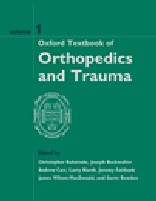|
|
|
| |
 |
|
|

|
 推薦指數:
推薦指數:





|
|
- 內容介紹
|
Oxford Textbook of Orthopedics and Trauma
Edited by Christopher Bulstrode, Clinical Reader in Trauma & Orthopaedics, John Radcliffe Hospital, Oxford, Joseph Buckwalter
0-19-262681-7
Publication date: 7 March 2002
3 volumes, 3130 pages, halftones throughout, 276x219
This is a new 3-volume, major reference work from the Oxford Textbook stable. The Oxford Textbook of Orthopedics and Trauma provides comprehensive coverage of the relevant background science and theory, practice and decision-making skills, and operative techniques required to provide modern orthopedic and trauma care. The text is divided into four major sections covering fundamental science, adult orthopedics, trauma and pediatric orthopedics. The fundamental science section contains a major subsection on tumors and the adult section is further subdivided to cover, systematically, the joint and bone systems of the body. Edited by a transatlantic team and written by more than 300 specialist chapter authors, this book is unrivalled in the field. The content is extensively referenced, highly illustrated and contains useful summary boxes throughout the text. The Oxford Textbook of Orthopedics and Trauma is essential reading for trainees and experienced practitioners alike.
Contents/contributors
Part 1: Fundamentals
1.1 Principles of epidemiology and research methodology
1.2 Measurement
1.3 Principles of diagnosis and management
1.4 Genetic disorders of the skeleton
1.5 The musculoskeletal system: structure and function
1.6 Tumors
1.7 Injury and repair
1.8 Hemoglobinopathies
1.9 Fundamentals of infection
1.10 Pain and its control
1.11 Biomechanics
1.12 Locomotion analysis
1.13 Imaging
Part 2: Adult orthopedics
2.1 Spinal disorders
2.2 Shoulder and elbow
2.3 Hand and wrist
2.4 Hip and pelvis
2.5 Knee
2.6 Ankle and foot
2.7 General disorders
Part 3: Trauma
3.1 Fracture classification
3.2
3.3 Complications of fractures
3.4 Management of the multiply injured patient
3.5 Orthopedic approach to the multiply injured patient
3.6 Principles of wartime surgery
3.7 Outcome after blast, missile, and gunshot wounds
3.8 The management of open fractures
3.9 Soft-tissue coverage
3.10 Combined vascular and orthopedic injuries
3.11 Limb salvage versus amputation
3.12 Principles of closed treatment of fractures
3.13 Principles of plate and screw osteosynthesis
3.14 Principles of intramedullary nailing
3.15 Principles of monolateral external fixation
3.16 Principles of circular external fixation in trauma
3.17 Absorbable implants
|
|
|

